We may earn income from links in this post. Please read this Disclosure for details.
While Guatemala is famous for its spectacular scenery and archeological sites, it’s also home to some of the world’s most incredible festivals, celebrations and holidays.
Here are 25 festivals in Guatemala you should add to your travel bucket list. They’re some of the most unique celebrations on the planet!
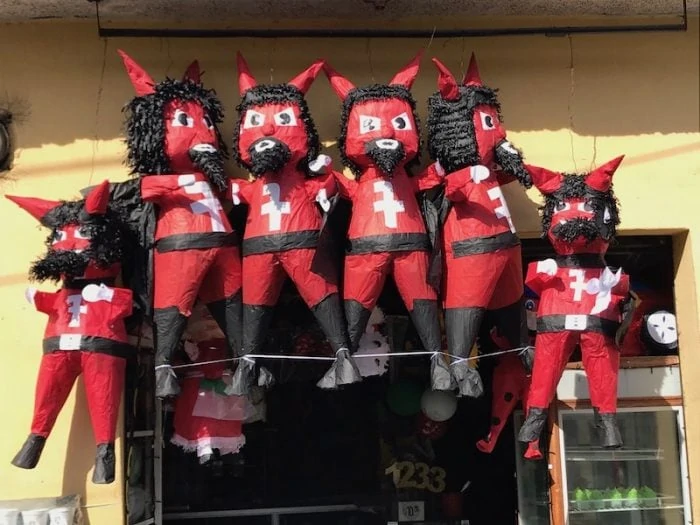
As someone who’s been visiting Guatemala for more than 25 years with my Guatemala-born husband and spending time with extended family across the country, I’ve experienced many of its festivals firsthand.
From local town fairs to major national celebrations, I’ve come to deeply appreciate how each Guatemalan event blends Mayan, pre-Hispanic, Afro-Caribbean, and Catholic traditions into unforgettable experiences filled with music, traditional food, special drinks and culture.
Below, you’ll find a month-by-month guide to Guatemala’s major holidays and festivals that deserve a spot on your cultural travel bucket list.
January 1 – New Year’s Day (Año Nuevo)
New Year’s Day, while an official holiday in Guatemala, is a quiet time when people recover from the festivities of New Year’s Eve (Año Nuevo.)
Many people head to beaches such as the black sands of Monterrico on the Pacific Coast or to the country’s balnearios, natural swimming pools created from clear mountain streams such as Balneario Pasabien in Zacapa.
New Year’s Day is also a popular time to enjoy popular foods or drinks to cure la goma or hangovers. Famous foods and drinks to look for include Guatemalan ceviche de cameron (shrimp ceviche), caldo de pollo (chicken soup) and picositas (spicy beer cocktail) are popular remedies to help recover from New Year’s Eve partying.
January 6 – Epiphany (el Día de Reyes)
In Guatemala, el dia de los tres reyes / Three Kings Day or Epiphany is not celebrated in as spectacular a fashion as in Mexico where special Rosco de Reyes is served and gifts are given.
In Guatemala, it’s more of a religious event, celebrated by the ringing of church bells symbolizing when the three wise men visited baby Jesus bearing gifts.
It’s also generally a time for families to take down their Christmas decorations.
January 14-15 – Pilgrimage to Black Christ of Esquipulas
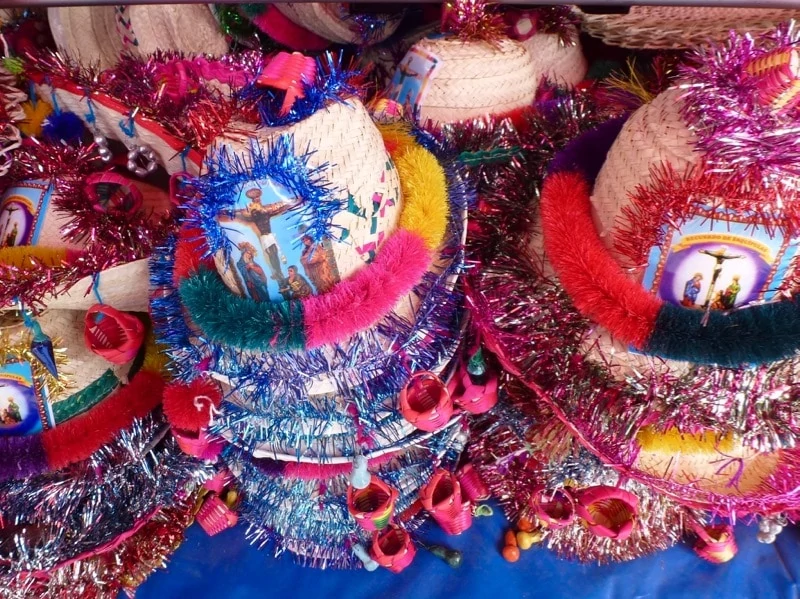
When it comes to religious traditions in Guatemala, the pilgrimage to the Basilica of the Black Christ in Esquipulas is one of the most important.
It is observed by Catholics and recognizes the image of Christ created by colonial sculptor Quirio Catano in 1594.
Housed within the Basilica, the statue of the Black Christ draws long line-ups of pilgrims who come to pay tribute to it from across Latin America.
Located next to the Basilica, the outdoor market of Esquipulas offers a fascinating look at Guatemalan culture and is packed with religious keepsakes, candies and the especially colourful sombrero de Esquipulas, a straw hat with dangling pompoms, tinsel and tassels worn by pilgrims.
February 2-4 – Coffee Harvest Festival in Guatemala
For culinary travellers, the coffee harvest festival that takes place in Fraijanes southeast of Guatemala City, is one of the most popular food festivals in Guatemala.
It features processions, music, traditional dance and of course, the famous local coffee grown on the volcanic slopes around Antigua and in the highlands.
In Guatemala, it’s popular to dunk a champurrada sesame seed cookie in your cup of coffee or cocoa. Make this Guatemalan version of Italian biscotti with our easy recipe for Guatemalan champurradas.
The Fraijanes Coffee Harvest Festival is also an opportunity to celebrate the Virgin of Candelaria or La Virgen de la Candelaria, also known as the Black Madonna, revered throughout Central America.
March/April – Semana Santa Guatemala / Holy Week Easter

The oldest and most important Christian festival, the date for Easter is not fixed but is calculated according to the lunar calendar. This means Semana Santa can take place anytime between late March to mid-April. In 2020, Easter Sunday will fall on April 12.
Semana Santa or Holy Week in Guatemala is such an incredible experience it’s truly unforgettable. Although celebrations take place throughout the country, this religious festival is at its colourful peak in Antigua where the streets are carpeted with alfombra, elaborate rugs made of dyed sawdust, created in a laborious process that takes teams of people a full day to construct.
Fruit such as mangoes, pineapples and oranges are also laid out in intricate patterns. Religious processions then move slowly through the streets walking on the carpets destroying them to the accompaniment of solemn music, swaying incense and groups of devotees. While processions take place each day, the largest processions take place on Palm Sunday and Good Friday.
Popular foods to eat for Semana Santa include pacaya (palm fronds) in batter, traditional salt cod dishes such as bacalao a la vizcaina , ejotes envueltos (battered green beans) and torrejas en miel (bread in honey).
If you plan to attend the famous Semana Santa celebrations in Antigua Guatemala, book early. Check out our recommendations for the three best budget hotels in Antigua Guatemala.
May 1 – Labor Day (El Día del Trabajo)
This holiday and worldwide celebration of the rights of workers also takes place in Guatemala with the largest event being a march through Guatemala City.
The march begins in Zona 5 at the Monument to Work and continues to Plaza de la Constitución. It’s often a protest march calling for improvements in working conditions so is not really a celebration intended for visitors.
May 29 – Ascension Day (Jueves de Ascencion)
One of the most important religious holidays in Guatemala, Ascension Day represents the 40th day of Easter.
On this day, the Mam Maya people celebrate Ascension Day at Lake Chicabal, a sacred lake set in the crater of Volcán Chicabal near San Martín Sacatepéquez in the department of Quetzaltenango.
Celebrations include flower displays, Mayan rituals and religious ceremonies.
The date for Ascension Day changes every year. In 2025 it’s May 29, 2026 it’s May 14 and in 2027 it will be May 14th.
June 24 – Festival of San Pedro in San Pedro La Laguna
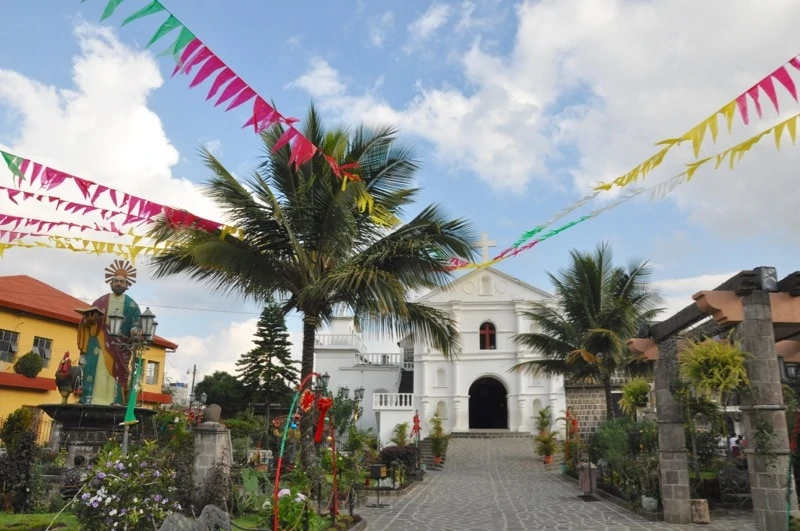
Every town in Guatemala has its own patron saint and will celebrate its Saint’s Day with parades, a midway for children, concerts, stage shows, beauty contests and agricultural exhibits.
All of the festivals are free so they’re a great thing to do in Guatemala if you’re on a budget.
One of the major festivals takes place in San Pedro La Laguna. Filled with tradition, it’s especially colourful and is worth planning to attend if you’re around Lake Atitlan on June 24th.
Last Week of July – Cobán National Folkloric Festival ( Rab´In Ajaw)

The Festival Folklórico Nacional de Cobán is one of the most exciting and memorable festivals in Guatemala. It’s an opportunity to see indigenous people dressed in traditional attire from all over Guatemala, each resplendent in a range of colours, traditions and characteristic patterns of weaving. A National Indigenous Queen of Guatemala is chosen amid much pomp and ceremony.
There are also folkloric dance performances and other authentic Guatemala traditions such as the famous local dish Kack-ik, a fragrant turkey stew made with the prized chile de Coban. There is a small cost to attend some of the ceremonies. The date varies each year so check with the Municipality of Coban in advance.
While in Coban, it’s worth adding a few days to visit the amazing natural wonders at Lanquin and Semuc Champey.
August 15 – Day of the Assumption (Día de la Asunción- Patrona de Guatemala)
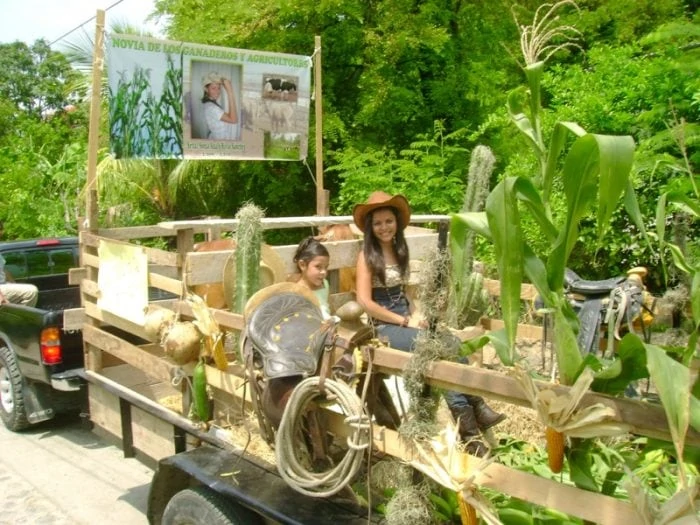
The celebration of the Day of the Virgin of the Assumption is celebrated throughout Guatemala.
But in Joyabaj Quiche it’s especially vibrant and features religious ceremonies, a rodeo, a midway with mechanical ride, processions, folkloric dances such as the Danza del Venado, marimba music and traditional foods such as jocon and pepian, the hearty chicken stew considered Guatemala’s national dish.
Independence Day – Día de la Independencia – September 15
How do people celebrate Independence Day in Guatemala? Expect lots of flag waving, blue and white banners, processions of marching bands with trumpets, trombones and drums, parades of school children through the streets and plenty of speeches by government officials.
One of the most important holidays in Guatemala, on Día de la Independencia you can also hear marimba bands and often be able to watch traditional dances such as the Christians vs the Moors and El Baile del Torito.
In Antigua, it’s sometimes possible to see the El Torito Loco, a spectacle where a dancer dressed like a bull straps a structure covered with fireworks to his back and twirls through the streets with much excitement, merriment and billowing smoke.
October 4 – Festival of Saint Francis of Assisi
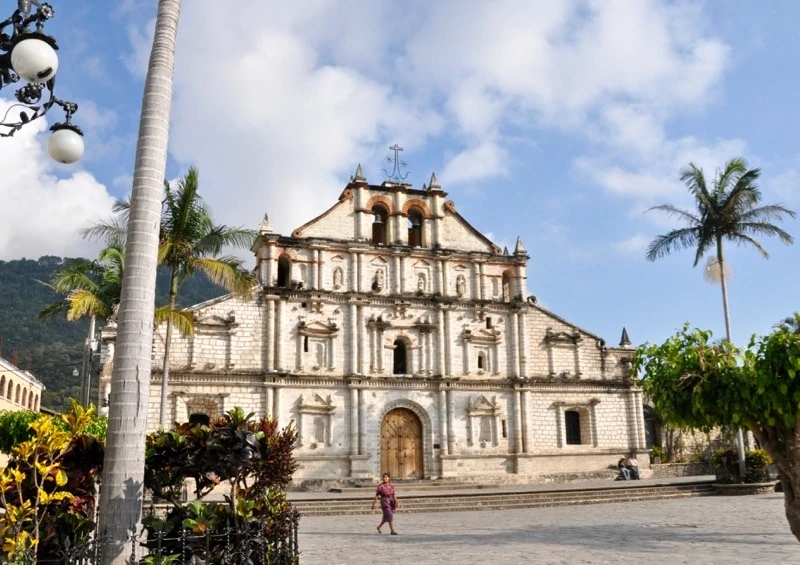
The feast day of the patron saint of animals is celebrated with fireworks, food and revelry in Panajachel on Lake Atitlan in the southwestern highlands.
The city’s 16th century Church of St. Francis of Assisi is a hub for many devotional ceremonies as well as indigenous Mayan markets.
A traditional dish to enjoy in Panajachel during the Festival of Saint Francis of Assisi is pulique, a chicken stew of Mayan origin, often prepared in enormous steel pots over an open fire.
Learn how to make it at home with our authentic Pulique Recipe.
October 12 – Columbus Day (Día de la Raza)
Columbus Day is a national holiday in Guatemala and is known as Día de la Raza or Day of the Race meaning Indigenous Peoples Day.
October 20 – Revolution Day (Comemoración de la Revolución de 1944)
A top location to celebrate Revolution Day is Guatemala City where thousands of people celebrate throughout the streets of the capital with exuberant live music, street food and fireworks.
November 1 – Drunken Horse Racing (Skach Koyl Festival)
One of the more bizarre Guatemala festivals that takes place each year across the Mayan Highlands around November 1st or Dia de Todos los Santos is the Skach Koyl or Drunken Horse Racing festival.
For three days leading up to the actual race on November 1, locals drink, dance, enjoy marimba music and carouse.
Then, on the day of the race, the competitors don special hats and drink themselves into a stupor, racing their horses along a circuit or through the village.
Many need to be tied to their saddles to avoid falling off their horses and getting trampled. Think of it as a booze-fuelled Guatemalan version of Spain’s running of the bulls.
The biggest, wildest and most dangerous Skach Koyl festival takes place in the village of Todos Santos Cuchumatán in the municipality of Huehuetenango.
During this seven hour race, locals binge-drink while riding their horses back and forth at high speeds. The winner of the race is the person who stays on his horse the longest.
Beyond the debauchery of its drunken horse racing festival, the village of Todos Santos Cuchumatán is remarkable for its distinct and well-preserved Mam Maya traditions.
Local men wear red and white striped trousers, shirts of blue, purple and white with an embroidered collar, plus straw hats with a woven ribbon. They generally carry a woven textile bag slung across their shoulder.
November 1-2 – All Saints Day Guatemala /Día de Todos los Santos and Día de Los Muertos /Day of the Dead
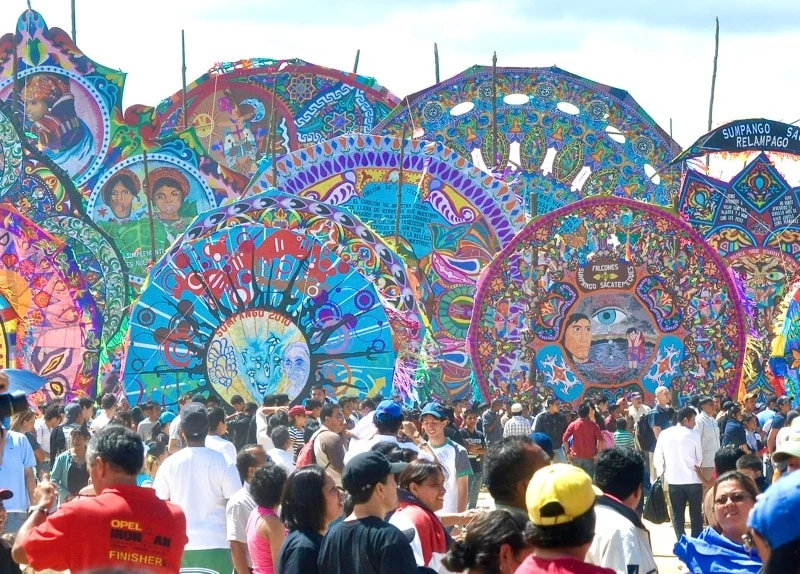
Taking place on November 1st of each year, the Dia de los Muertos Kite Festival is one of the biggest celebrations in Guatemala. If you have the chance to see just one festival in Guatemala this should be it.
Day of the Dead in Guatemala is a colourful affair. As in Mexico and throughout Central America, Guatemalans believe the barrier between the realms of the living and the dead is at its most porous on Day of the Dead (Día de los Muertos) and All Saints Day (Día de los Santos or Todos ) so it’s an ideal time to honour ancestors.
Top things to do during Day of the Dead include cleaning ancestral gravestones, decorating them with flowers and communicating with family ancestors by attaching messages to barriletes (kites) and letting the wind carry the messages up to the heavens.
November is an especially windy month so the best place to see these ceremonial kites are the barriletes fiestas held on November 1st in the central highlands near Santiago Sacatepéquez and Sumpango, west of Guatemala City.
These kites are enormous. At least 40 feet wide and made of bamboo and paper, they take teams of men to launch into the sky. It’s a spectacular sight to see them lift aloft and soar to the heavens.
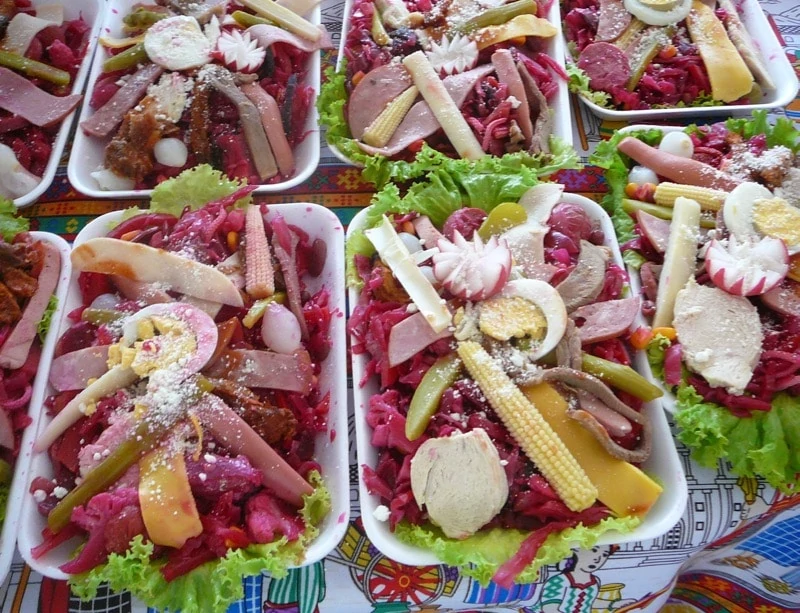
It’s also a popular time to enjoy fiambre, a traditional Guatemalan dish that’s basically an enormous salad featuring sliced meats and chilled vegetables. It’s — eaten only during these two days of the year.
Other typical foods for Day of the Dead include blue corn tortillas made on a comal, fried chicken, venado (white rum), grilled corn on the cob and platano en mole negro (plantain in spicy chocolate sauce).
Read more about Day of the Dead traditions in Guatemala.
November 26 – National Day of the Garífuna or Garifuna Settlement Day
Get ready to dance, eat and drink if you’re planning to attend Garifuna Settlement Day.
Taking place in Livingston on Guatemala’s Caribbean coast and drawing people of Garifuna heritage from Belize, Honduras and Guatemala, the National Day of the Garifuna is a three day celebration of Afro-Caribbean culture.
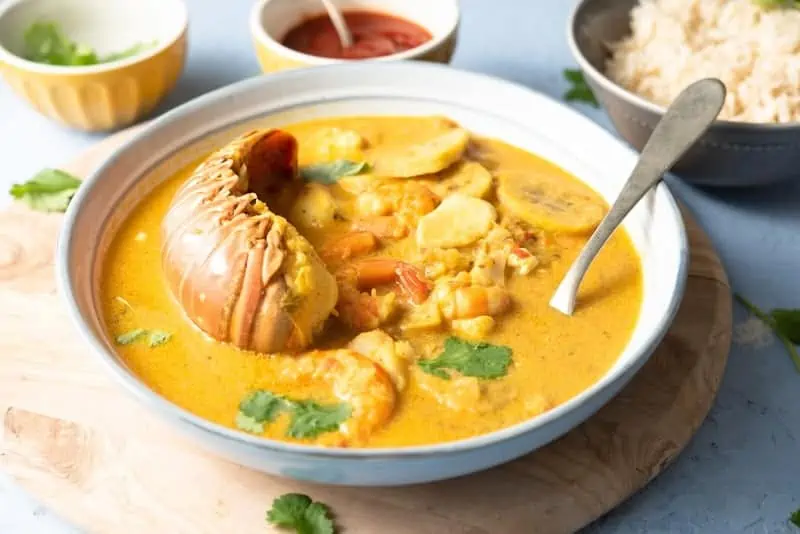
There’s dancing in the streets, traditional foods such as tapado seafood soup and coconut buns as well as unique ceremonies.
One popular custom is the launching of decorated dugout canoes in a reenactment of the first Garifuna to arrive on the coast from West Africa.
December 7 – Burning of the Devil Guatemala Festival ( La Quema del Diablo)
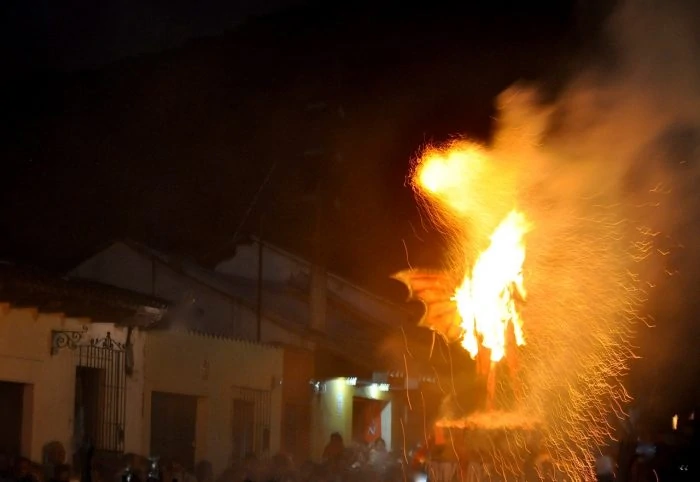
During the evening of El Dia del Diablo on December 7th each year, Guatemalans burn papier-mache effigies of the devil along with household garbage, outside their homes in the streets.
Deeply rooted in pre-Hispanic traditions, this festival is a ritualistic cleansing for the holy Christmas season.
Public displays of La Quema del Diablo (the burning of the devil ) are also hosted by municipal authorities and supervised by firefighters.
The largest of these burning of the devil festivals takes place in Antigua, Guatemala and features street food, mariachi music and of course the torching of a giant effigy of the devil after sunset.
This Antigua Guatemala event draws huge crowds to the narrow streets which presents prime opportunities for pickpockets and other street crime.
Read our post with 20 Tips for Safe Travel in Guatemala before you attend.
December 8 – Virgin of Conception (Virgen of Concepcion)
The Catholic Feast of the Virgin of Immaculate Conception takes place nine months before the feast of the Nativity of Mary on September 8th.
One of the most religious Guatemalan festivals throughout the country, it’s even been recognized by the Guatemalan government as a Cultural Intangible Heritage of Guatemala.
Of course, like most top celebrations in Guatemala, the drink of choice is the award-winning local rum, Ron Zacapa Centenario or venado.
December 12 – Virgin of Guadalupe Day Guatemala (Día de la Virgen de Guadalupe)
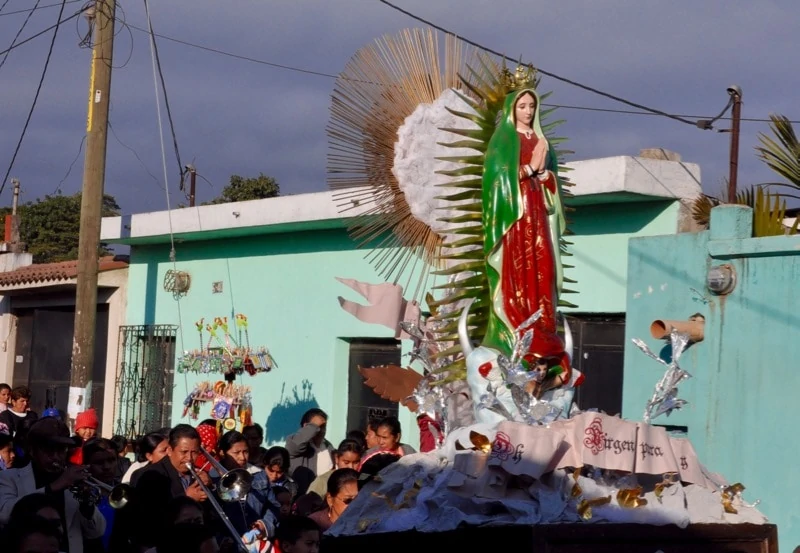
Although the Virgin of Guadalupe is best known in Mexico, she is also revered throughout Guatemala.
On December 12, believers celebrate the day she first appeared in 1531 by erecting shrines decorated with flowers and votive candles to Our Lady of Guadalupe in their homes, neighbourhoods and churches.
During el Día de la Virgen de Guadalupe in Guatemala, there are also processions, brass bands, fireworks and traditional street food. Children dress in traditional clothing and reenact the drama of Juan Diego and Our Lady and Las Mañanitas birthday song is sung at special times during the day.
December 13-22 – St. Thomas Festival (Fiesta de Santo Tomás)
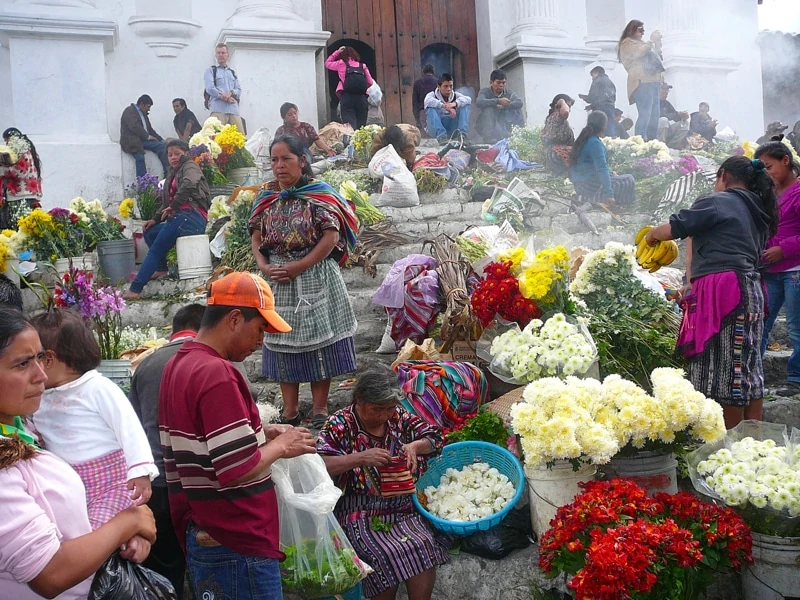
Each Thursday and Sunday, the indigenous K’iche’ Maya transform the small village of Chichicastenango ( called Chichi for short) in the Guatemalan highlands into a raucous market filled with colourful weavings, flowers, handbags, live chickens and vegetables. But on December 13, it’s home to a week-long celebration honouring the town’s patron saint, Santo Tomás.
During the Fiesta of Santo Tomás, local people from the cofradias ( brotherhoods representing the town’s 14 saints) supervise the preparation of the dances where participants dress in costumes representing Spanish conquistadors and dance through the streets accompanied by music, cheering and fireworks.
The grand finale of the celebration is the Palo Volador, a spectacle during which costumed dancers ascend a very tall pole ( 100 metre or 33 feet) and then, after tying their feet by rope, jump off a platform to spiral downward to the ground.
Hotel accommodations are very pricey and hard to get during the Fiesta de Santo Thomas so your best bet is to stay in a hotel in Panajachel on Lake Atitlan and take one of the inexpensive shuttles that run regularly to Chichicastenango.
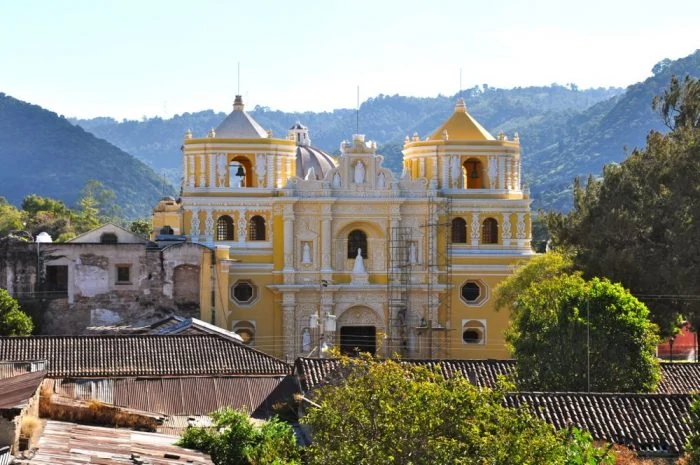
These evening processions called las posadas navideñas start nine days before Christmas and begin with the clink, clink, clink of chinches (turtle drum shells) and a fresh round of fireworks, signifying a posada is about to begin.
Accompanied by song, candles and sometimes a full brass band, the processions — often featuring children dressed as Mary and Joseph – stop at homes along the parade route, symbolically requesting lodging for the night.
Each time, they are refused as Mary and Joseph were in the story of the Nativity. When the processions reach the designated destination or “inn” hosting the party of the night, traditional food and drink such as ponche de frutas, a hot fruit punch are served.
Antigua, the colonial capital, makes an ideal base for visitors to experience this special Guatemala festival and Christmas tradition.
Many of the las posadas navideñas begin at the Catholic Church of La Merced, located at the northern end of 5a Avenida, near the popular hotel Posada la Merced and several highly recommended Spanish language schools.
There are also several restaurants open during the holiday period where you can enjoy traditional Guatemalan dishes as well as international favourites such as Ensalada de Nochebuena
December 24 – Christmas Eve (Noche Buena)
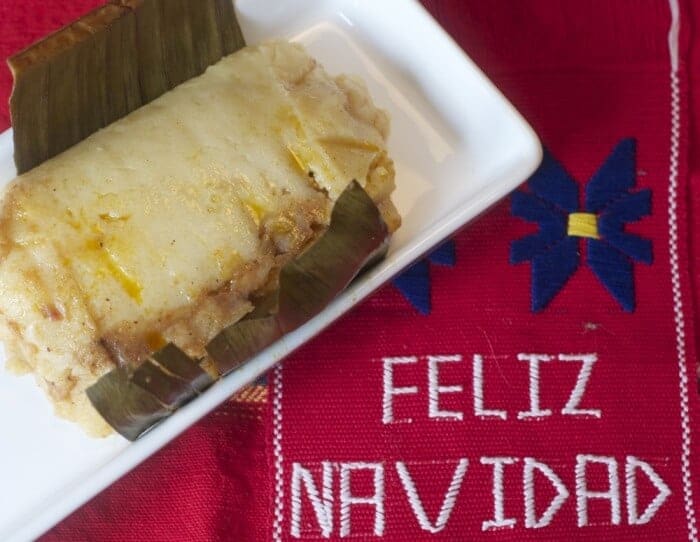
Christmas Eve or Noche Buena is the most significant holiday of the Christmas season in Guatemala.
It’s a time when families gather together in their homes and it features gift-giving for children, midnight mass and the serving of traditional food such as tamales, pavo en salsa (turkey) or other meat.
The most popular drink is ponche de frutas, a hot fruit punch of apples, pears, pineapple and other fruits as well as cinnamon. It’s served with or without alcohol such as Ron de Zacapa or venado.
At midnight, fireworks explode in the streets and people hug each other with an Abrazo de Navidad wishing each other “Feliz Navidad.”
More food is served, people visit the homes of neighbours and friends to admire their nativity scenes and the partying continues until 3:00 am or later.
Given the festivities of Christmas Eve, Christmas Day is a much quieter day with simple food such as caldo de gallo (chicken soup) served. It’s a day to recover from the festivities of the posadas and noche buena and spend time with family.
December 31 – New Year’s Eve (Fin del Año)
Plaza Mayor in Guatemala City is the hub for celebrating New Year’s Eve in Guatemala. One of the best New Year’s Eve parties in Guatemala takes place on the rooftop of the Hyatt Centric Hotel.
This party features DJs spinning music, special cocktails and food celebrating the New Year with spectacular views of the fireworks across the skyline of Guatemala City, the surrounding volcanoes and the iconic Torre del Reformador, the country’s version of the Eiffel Tower.
Save to Pinterest!
Like this Post? You Might Also Enjoy These:
3 Budget Hotels You’ll Love in Antigua, Guatemala
Salpicon de Res: Shredded Mint and beef appetizer
Pulique: A Ceremonial Chicken from A Mayan Cooking Class in Guatemala


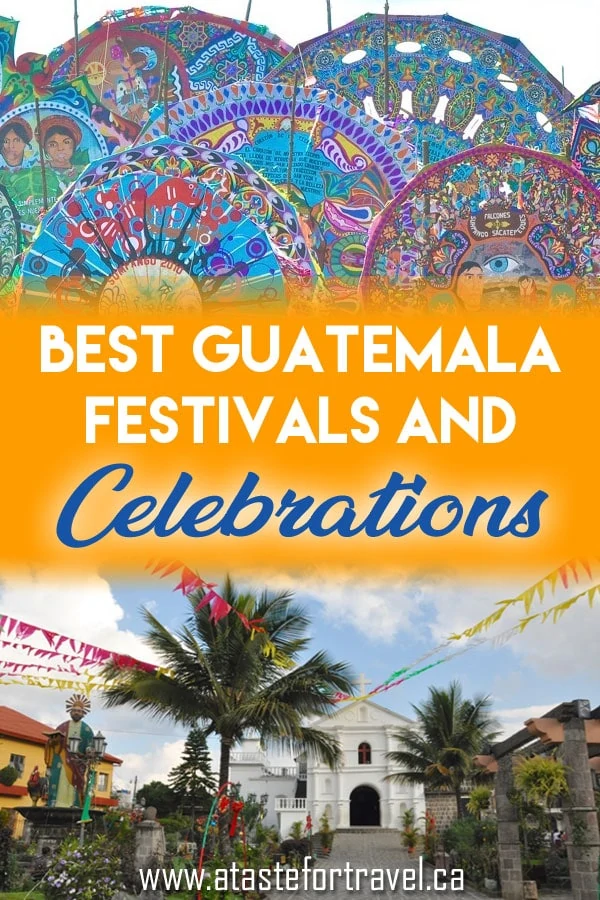
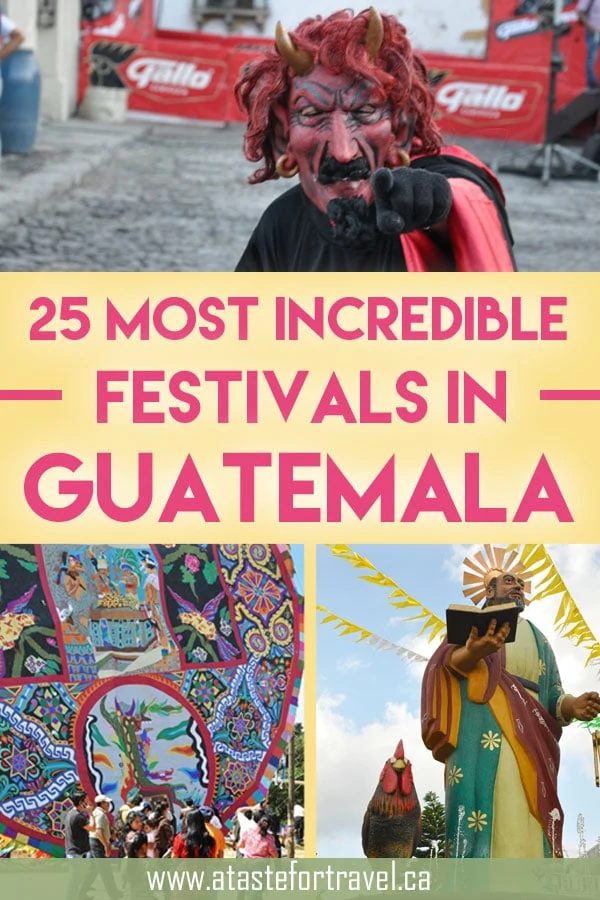
 10 Can’t-Miss Beach Bars in Aruba
10 Can’t-Miss Beach Bars in Aruba
No lo se'
!Esto es maravilloso! Creo que decribiste mi pais a la perfecction’
Pat Mitchell
My adopted granddaughter Is Guatemalan. She is 13 and has decided she want to celebrate the Guatemalan holidays and festivals in 2021. I’m trying to find something like this in print to give to her. Any suggestions?
Michele Peterson
Hi Pat, How wonderful your granddaughter is planning to celebrate Guatemalan holidays and festivals next year! The website http://www.timeanddate.com has the ability to print a calendar with national holidays of a selected country printed on it. However it doesn’t have much information about the festivities themselves. Food is a major part of every Guatemalan celebration and she might enjoy trying some of the traditional dishes. Did you subscribe to our newsletter? We send out seasonal information monthly and always include information on Guatemala and easy recipes. In the meantime, I’ll check with our designer and see if there is a way to create a PDF of this post.
Pay Mitchell
My adopted granddaughter Is Guatemalan. She is 13 and has decided she want to celebrate the Guatemalan holidays and festivals in 2021. I’m trying to find something like this in print to give to her. Any suggestions?
Mari
Yes! I am an adopted Guatemalan, and you should make some food for her and write down these facts! P.S. I am 13 too!
Patti Morrow
I had no idea Guatemala has so many festivals! I’d definitely love to see the ceremony with the kites! So colorful!
Nancie
Hi Michele. What a great list. I would be happy attending any of these festivals. I like the fact that special food is often available. In your opinion, what’s the best time of the year to visit Guatemala?
Michele Peterson
Hi Nancie! Glad to hear you liked the food tips! Guatemala is known as the Land of Eternal Spring as in the capital and highlands the temperatures rarely rises above 25C. Late summer and early fall are the rainy season and March – May can be very hot at the beaches and in the lowlands so it really depends where you are planning to go. Overall Guatemala is a year round destination so you can choose your travel dates based on what you want to experience. Like other destinations, holiday periods are the most expensive.
No lo se'
Probablemente verano o primavera
Irene S. Levine
I love the idea of planning a trip around a festival. These in Guatemala look great!
Cindy Carlsson
What a useful post!! I hope to get to Guatemala some day. When I do, you can be sure I will make use of your wonderfully helpful list of Guatemala’s festivals.
Jeff & Crystal Bryant
Wow! We never realized the breadth of festivals held in Guatemala. I think it’s time for us to begin researching our own visit there. Thanks for sharing.
Carol Colborn
Thanks for the list. We have so many similar festivals in the Philippines, since we are also of Spanish heritage. But, not that Burning the Devil one and we have other patron saints.
No lo se'
Si,seria genial vivir las Filipinas!
Doreen Pendgracs
Thx for this wonderful post, Michele. I’ve only been to Lake Atliclan, so I definitely have a lot more of Guatemala to discover. As there is tremendous chocolate being made in the Coban area, I would especially love to visit this region.